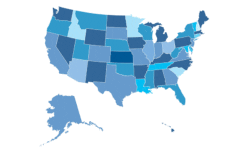Duress Alerting Improves Schools’ Situational Awareness
Panic alarms are another tool that can supplement law enforcement and video surveillance.
Detailed alerts must be delivered to the people best qualified to respond via the communication devices they actual use. Sending an alert to a browser will be of no use to mobile personnel such as school resource officers. Today, situational awareness driven to as many screens as possible is key – from workstations (desktops and laptops), smartphones and pagers to tablets and digital signage, including TVs. Such mass notification enables redundancy and mobility to greatly enhance life safety.
In fact, mobility is part of an ideal situational awareness strategy. With video pages and maps delivered to mobile devices in combination with alerts about a triggering event such as a fire or armed intruder, teachers and students can be made aware of imminent danger so they can move away from it. Given this technology, the hunker-and-wait emergency lockdown eventually will become an outdated practice.
Lack of Funds, Infrastructure Poses Problems
Granted, K-12 schools have encountered problems in implementing technology, the most common being funding and a lack of infrastructure to maintain and upgrade safety and security systems. A subscription-based, software-as-a-service model answers these challenges by allowing a school to contract a monthly service for fixed and/or mobile duress equipment rather than make a large capital expenditure. The associated service agreement ensures that the technology remains fresh in addition to providing remote supervision and backup.
The same smart networks, devices and software that power mobile and/or fixed duress also make it possible to integrate every existing life safety, security and environmental system and easily add new sensors within a single school or multi-facility campus. Random alarms from these disparate systems then can be converted into detailed alerts for delivery to key individuals, select groups or entire populations depending on the situation and its severity. Access control systems, fire panels, water sensors and cigarette busters in restrooms, temperature monitors in cafeteria refrigerators, motion detectors at eye-wash stations in the science lab – each can be integrated with a single yet powerful alerting engine.
Related Article: 16 Steps to Better School Front Entrance Security
Centralize
d monitoring, alerting and reporting gives you a wide view of what’s happening in and around your school in real time to help save lives and property, protect operational continuity, and prevent loss of convenience/comfort. If panic is caused primarily by a lack of information, then doesn’t it stand to reason that the more awareness people have, the greater their chance for survival in the event of an emergency?
Our Children Deserve Our Best
So while we continue to wrestle with the how – as in how did we reach this point? – let’s not lose sight of the why and the now. We all have a vested interest in our children. After all, they’re our future mothers, doctors, legislators and business leaders. They deserve that we push through our apathy and take practical and available steps sooner rather than later to improve their safety at school.
Those who prepare will be the beneficiaries. Look at how far driver safety has come over the decades since society decided deaths from auto accidents was a problem. While the best air bag is the one that is un-deployed, all cars come with them now. Hopefully school administrators and parents are ready to buckle down on school safety as they now buckle up in their cars.
Mike MacLeod is president of Status Solutions. For more information, visit www.StatusSolutions.com.
Note: The views expressed by guest bloggers and contributors are those of the authors and do not necessarily represent the views of, and should not be attributed to, Campus Safety magazine.
If you appreciated this article and want to receive more valuable industry content like this, click here to sign up for our FREE digital newsletters!
 Leading in Turbulent Times: Effective Campus Public Safety Leadership for the 21st Century
Leading in Turbulent Times: Effective Campus Public Safety Leadership for the 21st Century
This new webcast will discuss how campus public safety leaders can effectively incorporate Clery Act, Title IX, customer service, “helicopter” parents, emergency notification, town-gown relationships, brand management, Greek Life, student recruitment, faculty, and more into their roles and develop the necessary skills to successfully lead their departments. Register today to attend this free webcast!







